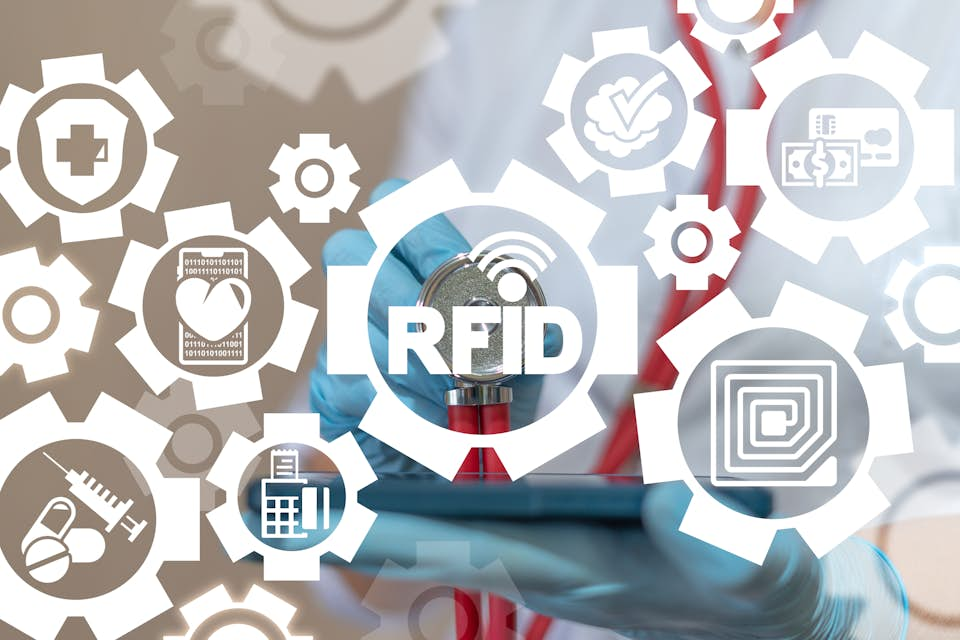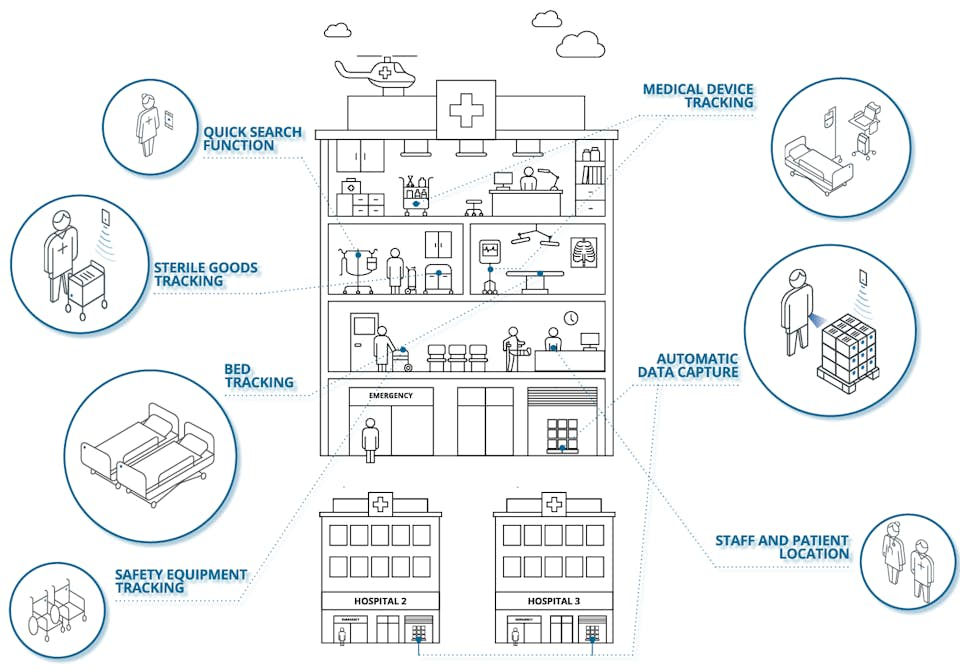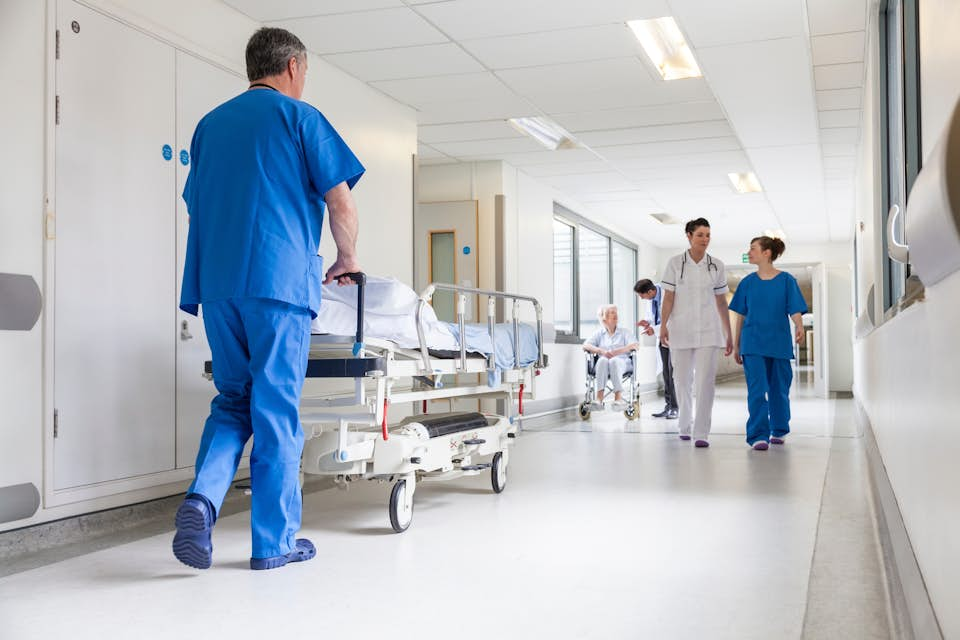The key benefits of RFID use in healthcare
Dive into the world of RFID technology and its pivotal impact on patient care, operational agility, and safety within dynamic hospital environments. Discover how RFID streamlines asset tracking, accelerates equipment access, and transforms healthcare delivery.

RFID use in healthcare:
Is it worth it in a hospital environment?
Let’s start with what RFID is. Radio-frequency identification (RFID) uses electromagnetic fields to automatically identify and track tags attached to objects, animals and people, enabling us to search for, identify, track and communicate with them. Now we know how RFID is defined, let’s explore why it’s particularly useful, even critical, in a healthcare and hospital environment.
Hospitals are busy, fast-paced and complex places, full of people and equipment – mostly mobile – all going in different directions with varied tasks and needs. Therefore, staff time and operational efficiency are critically important. This is where RFID technology comes in. Knowing the location of medical equipment – information which RFID technology can provide – is vital to the everyday running of a hospital. To be able to treat a patient effectively, there’s a requirement and often urgency to have the right medical device at the point of need.
The maintenance and safety of medical devices is also supported through RFID technology. The sheer scale of thousands of items, all being moved to various parts of a hospital as and when they’re needed requires serious logistical planning and management to ensure they’re all properly maintained, cleaned and fit for purpose, mitigating the risk of causing infection or injury to patients.
So, to answer the question whether RFID technology is worth it in a hospital environment:
Yes, absolutely. The use of RFID technology is particularly well placed to improve operational efficiencies and maintain patient safety in a hospital

Lead the way with RFID use in healthcare
When an RFID technology solution is implemented, hospitals can detect every asset in range through RFID mobile readers (handheld terminals) or RFID ceiling mounted devices. Mobile readers allow staff to manually register hospital assets and change the status of an asset if required. You could walk into a room with a mobile reader and identify each and every asset that’s situated there at the touch of a button, with a high degree of accuracy.
Ceiling mounted readers, on the other hand, are strategically placed throughout the hospital and act as choke points for RFID tracking in critical locations. Unlike barcode scanning, which requires each item to be individually scanned, fixed readers can detect hospital assets within 3-4 meters. When an asset passes a fixed reader, it is recorded as moving in a particular direction, which enables hospital personnel to locate the ward or departments it has passed through or been moved to.
There have been great strides in the investment of hospital RFID tracking solutions since the introduction and adoption of GS1 standards to improve patient safety and operational efficiencies. The success of the Scan4Safety pilot in the UK has accelerated its use, providing much needed performance data to support further investment. The results speak for themselves – there is now overwhelming evidence that RFID use in healthcare dramatically improves asset utilisation, reduces inventory levels and frees up time, making hospitals more efficient, improving the safeguarding of patients and providing higher quality patient care.
Efficient and high-quality patient care
Improving patient care is a priority for all healthcare providers. The quality of patient care is determined by many factors – one of which is operational systems, which can be transformed using data capture with RFID technology.
Using a simple web-based search to locate an item prevents hospital staff from wasting time searching for medical devices, meaning patients are seen and treated more quickly due to equipment availability. This also applies to clinical engineering teams that must locate medical equipment to be able to service them. Properly maintained equipment supports patient safety initiatives.
RFID technology also reduces the risk of human error. Hospital staff have to carry out regular audits on medical devices. As RFID tracking solutions capture data in real time, they are performing a constant, rolling audit, which is highly accurate and not susceptible to human error.
Asset utilisation is hugely important. Hospitals are busier than ever with high occupancy, so being able to admit and discharge patients quickly is critical. Locating devices quickly and easily is directly linked with patient treatment times and discharge times. For example, a bladder scanner might be required to discharge a patient. No bladder scanner, no patient discharge. This not only wastes time but it also delays the admission of a patient who needs the bed. Using RFID in healthcare, the bladder scanner could be quickly located, improving patient flow and, in turn, patient care.

Optimize your hospital logistics with X-Tracking
Learn more about our healthcare solution Lyngsoe X-Tracking
Learn how X-Tracking is used
Bed Tracking
Bed tracking and bed management are both crucial in hospitals. Bed management involves allocating and providing beds efficiently, while bed tracking provides real-time visibility of bed locations and statuses. Both are essential for optimizing patient flow and maximizing bed utilization.
Sterile Goods Tracking
Efficient sterile goods management is critical in hospitals to ensure timely patient care. Accurate tracking of sterilized instruments and equipment minimizes delays and optimizes efficiency, reducing operational challenges and staff burden.
Medical Devices Tracking
Tracking mobile medical devices is crucial in busy hospital environments. Categorizing devices based on risk helps prioritize their management. Low-risk devices (Class I) include non-electric wheelchairs, bandages, and some handheld surgical instruments, requiring minimal maintenance.
Safety Equipment Tracking
Safety equipment in hospitals, including patient moving and handling tools and respiratory protective equipment (RPE), plays a critical role in protecting both patients and staff. Efficient tracking of these items ensures safe mobility and minimizes the risk of infections.
